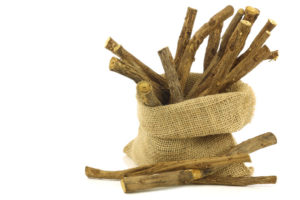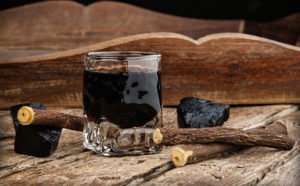Licorice (Glycyrrhiza plants, usually the Glabra species) have been used in Traditional Chinese Medicine to a long time for various digestive and health problems, and as a general vitality promoting agent. People know Licorice mostly as a candy product, and is inherently a functional food rather than just a candy (as the oil containing the traditional licorice flavor also contains some bioactive compounds).
The part that is used in medicine is the dry root. Also known as “sweet root,” licorice root contains a compound that is about 50 times sweeter than sugar. Licorice root has been used in both Eastern and Western medicine to treat a variety of illnesses ranging from the common cold to liver disease. It acts as a demulcent (a substance relieving inflammation or irritation), a soothing, coating agent, and as an expectorant, meaning it helps get rid of phlegm.

One of the most important compounds in Licorice appears to be Glycyrrhizin, which is the sugar-bound form of Glycyrrhizin Acid (a triterpene glycoside). This agent increases cortisol and reduces testosterone. If you take supplements (pills or tinctures) and you are experiencing side effects try to get products with low Glycyrrhizin content (less than 500mg total dose daily). 150 mg has been confirmed to not influence these hormones. To reduce the influence of their products on these hormones, many companies remove Glycyrrhizin from their formulations and the product is now called DeGlycyrrhizinated Licorice (in short DGL).
Benefits of Licorice
Reduction of LDL (the “bad” cholesterol)
In human studies, the reduction of LDL was notable after supplementing with licorice. LDL oxidation is known to contribute to atherosclerosis (plaque buildup in arteries), and reducing the rate of LDL oxidation reduces atherosclerosis. Atherosclerosis is at the leading cause for strokes and heart attacks.
Peptic ulcers
DGL is often suggested as a treatment for stomach ulcers. A few studies have found that DGL and antacids helped treat ulcers as well as some prescription drugs.
One animal study found that aspirin coated with licorice reduced the number of ulcers in rats by 50%. (High doses of aspirin often cause ulcers in rats.) In one study, licorice root fluid extract was used to treat 100 people with stomach ulcers, 86 of whom had not improved with conventional medication, for 6 weeks. Ulcers disappeared in 22 people; 90% of participants got better. Other studies have found that DGL had no effect on peptic ulcers in humans.
Canker sores (Apthous ulcers)
One small study suggested that gargling with DGL dissolved in warm water 4 times per day helped reduce pain among people with canker sores.
Eczema
In one study, licorice gel, applied to the skin, helped relieve symptoms of itching, swelling, and redness. A gel with 2% licorice worked better than a gel with 1% licorice. Glycyrrhiza glabra extract, or licorice root extract, may be effective against bacteria that can infect the skin.
Dyspepsia (indigestion, GERD)
Preliminary studies suggest that a specific herbal formula containing licorice, called Iberogast, may help relieve symptoms of indigestion or gastroesophageal reflux disease (GERD). This herbal formula also contains peppermint and chamomile, two herbs often used for indigestion.
Upper respiratory infections (cold, cough)
Licorice is a traditional treatment for cough, asthma, and sore throat. One study found that gargling with licorice before getting anesthesia cut the incidence of postoperative sore throat by half.
Weight loss
One study found that a preparation of licorice may reduce body fat. Fifteen people of normal weight consumed 3.5 g of licorice each day for 2 months. Body fat was measured before and after treatment. Licorice appeared to reduce body fat mass and to suppress the hormone aldosterone; however, the people in the study retained more water.
Another study found that a topical preparation of glycyrrhetinic acid (a component of licorice) reduced the thickness of fat on the thigh in human subjects. A third study found that people who took 900 mg of licorice flavonoid oil daily for 8 weeks experienced reductions in body fat, body weight, body mass index, and LDL cholesterol levels. More studies are needed to say if licorice really helps reduce fat. In addition, taking licorice long term has a number of health risks.
Hepatitis C
Glycyrrhizin may help treat hepatitis C, a virus that infects the liver. Without treatment, hepatitis C can cause inflammation and long-term liver damage. Research has reported that glycyrrhizin demonstrates antimicrobial activity against hepatitis C in cell samples and may hold promise as a future treatment for this virus. Doctors in Japan use an injectable form of glycyrrhizin to treat people who have chronic hepatitis C that does not respond to other treatments.
Menopause
Preliminary research suggests licorice may be effective at reducing hot flashes. One study found that licorice seems more effective than Hormone Replacing Therapy (HRT) in improving hot flash duration.

Side effects (toxicity) from too much licorice
Licorice with glycyrrhizin may cause serious side effects. Too much glycyrrhizin causes a condition called pseudoaldosteronism, which can cause a person to become overly sensitive to a hormone in the adrenal cortex. This condition can lead to headaches, fatigue, high blood pressure, and even heart attacks. It may also cause water retention, which can lead to leg swelling and other problems.
Glycyrrhizin has also been reported to reduce thyroid activity and basal metabolic rate (BMR).
The toxic dose is in excess of 20 grams/day. Minimum side effects can be achieved at less than 10 grams/day of products with glycyrrhizin.

I remember there was a case in the media in 2020 that a man had died from licorice. “A Massachusetts construction worker died after eating bags of black licorice for an extended period of time, which caused his heart to stop, according to The Associated Press. The 54-year-old ate a bag and a half every day for a few weeks, which created an imbalance in vital nutrients and affected his blood pressure.” Beware.
Pregnant or breastfeeding women should not take licorice. Some studies suggest that taking licorice during pregnancy can increase the risk of stillbirth.
DeGlycyrrhizinated Licorice (DGL) is not associated with any adverse effects.
It is recommended, in general, not to take any licorice product for longer than 4 to 6 weeks.
